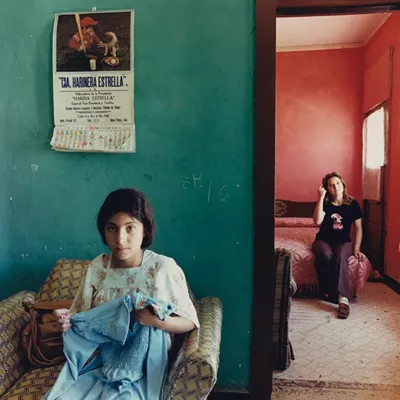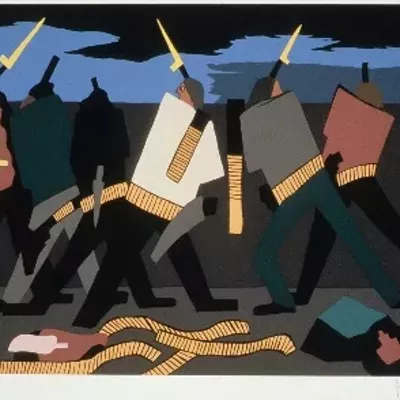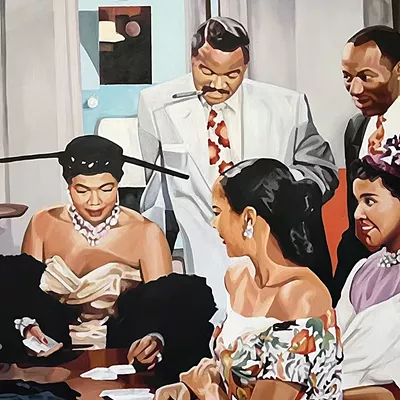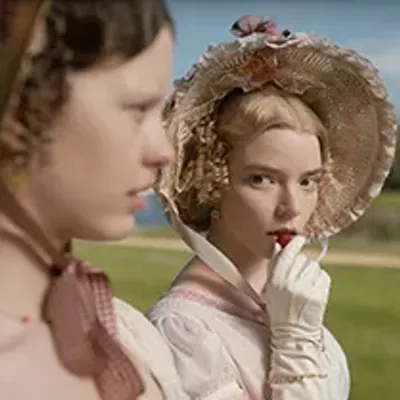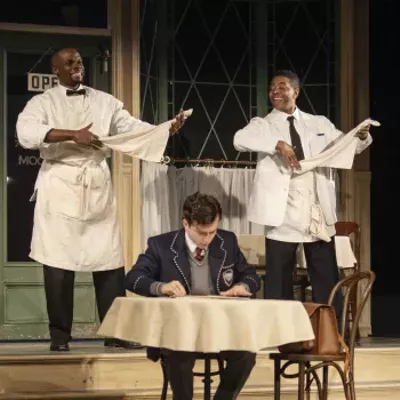Why did the chickens cross the road?
To get to Hotel Congress, of course.
In the world according to Carolyn Anne Anderson, sprightly chickens hotfoot it not only to Hotel Congress, but to a host of other iconic Tucson sites. They flock to the Rialto Theatre, scratch outside of the Buffet bar, scamper sheepishly away from the No-Tel Motel, shelter in the shadow of the Paul Bunyan statue, loiter outside of the Loft and peck around in the parking lot of Beyond Bread.
Anderson's whimsical paintings, Pollos del Pueblo (Chickens of the City), are at Gallery 801, in a first-ever solo show for this emerging artist. The seven acrylics on canvas share the gallery space at the edge of the Dunbar/Spring neighborhood with earlier Anderson canine portraits.
"Why Did the Chickens?"—the work with a trio of handsome hens tripping across Congress Street on high-clawed feet—is the one that started Anderson's poultry predilection. She painted it earlier this year after Dinnerware Artspace put out a call for chicken art. Before she tried her hand at hens, Anderson had almost always painted dogs. After a paralyzing accident at the age of 17, she learned to negotiate life in a wheelchair, and around 2005, she began painting portraits of her beloved service dog, the late Tyler, a black lab. (See "'Old' Artists, New Tricks," March 26.)
But for Dinnerware's Pollos del Pueblo (Anderson later borrowed the name for her series), she hit on the idea of chickens preening their way through Tucson. For that first work, she chose to picture Congress Street by night.
The carefully painted Hotel Congress sign glows yellow against an inky black sky. Globes of white lamplight spill into the street, allowing the three eager hens to safely step across the road. The hotel looms ahead on the diagonal, pictured at its corner point at Fifth Avenue and Congress Street, a beacon for birds on the make.
The people del pueblo were charmed by Anderson's fowl, and after that first success, there was no stopping her, says Steven Derks, who runs Gallery 801 out of his studio at Main Avenue and University Boulevard. She forged ahead, imagining chickens in the In Crowd at some of Tucson's coolest places.
"Hen Party at the Rialto" captures the old theater in the early-morning light. A streak of pale pink crosses the blue eastern sky. The sky is the only bit of nature in Anderson's urban streetscapes, unless you count the scraggly trees that wrap around the edge of this painting. The theater is more carefully rendered than its Hotel Congress neighbor; its green roofs and latticework are catalogued, along with its red-brick façade and empty storefronts.
As she does in all the works, Anderson lavishes attention on the Rialto sign. White vertical letters march down a maroon background, above a white sign shimmering pink in the dawn. It announces a hip lineup of local acts: Calexico, Lisa Otey, Howe Gelb. The two chickens, though, seem to be fleeing the theater in a panic, heading right for the foreground. You can almost hear the brown one squawking. Either these partiers are up with the chickens—or roosters—or they've been out all night.
Same goes for the couple staggering out of the No-Tel, a famously seedy motel. These fornicating "Chickens at the No-Tel" are stumbling into the dawn, too, having long since overstayed their adulterous hours. "Cocktails at the Buffet," another nighttime piece, pictures a couple of pompous chanticleers about to engage in a Michael Vick-esque battle to the animal death. Fine fellows in white feathers with coxcombs, they scratch the ground and aim their heads threateningly at each other, a pair of macho drunks deteriorating outside the dive.
What's fun about these witty pieces is that the chickens are such convincing stand-ins for humans. Somehow, Anderson has managed to endow their fluffy little selves with the poignancy of the human condition. Just like us, they have foibles and lusts and sorrows, and they're fated to repeat their little dramas again and again.
Anderson seems to have quite an affinity for animals. Her chickens are attentively and affectionately rendered, from their combs to their wattles, and from the little red hens to the big white roosters.
Not all of the works are well-painted. Anderson often seems to rely on paint right out of the tube, and once in a while, her drawing seems off. Paul Bunyan, for one, looks a little off-kilter. But she's got a great idea going here, and with more time in the studio, she could turn this project into a Tucson institution.
Just imagine: chickens here, there and everywhere, cluck-cluck-clucking all over town.
The gallery also is displaying metal sculptures by Dan Lehman, Peter Eisner, Bryan Crow, Ian Houghton and Derks. Derks, who maintains a studio on the property, is also showing his abstract paintings on aluminum and a series of wall works in concrete and metal.

